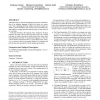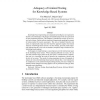114
Voted
ICST
2009
IEEE
14 years 10 months ago
2009
IEEE
Measurement and detection of redundancy in test suites attempt to achieve test minimization which in turn can help reduce test maintenance costs, and to also ensure the integrity ...
112
click to vote
KBSE
2010
IEEE
14 years 11 months ago
2010
IEEE
Although testing is central to debugging and software certification, there is no adequate language to specify test suites over source code. Such a language should be simple and c...
111
click to vote
IEE
2010
14 years 11 months ago
2010
Popular code coverage measures, such as branch coverage, are indicators of the thoroughness rather than the fault detection capability of test suites. Mutation testing is a fault-...
115
Voted
ICST
2010
IEEE
14 years 11 months ago
2010
IEEE
—When a program is modified during software evolution, developers typically run the new version of the program against its existing test suite to validate that the changes made ...
100
Voted
STVR
2002
15 years 11 days ago
2002
Test-suite reduction techniques attempt to reduce the costs of saving and reusing test cases during software maintenance by eliminating redundant test cases from test suites. A po...
111
click to vote
IJAIT
2000
15 years 16 days ago
2000
Knowledge-based engineering and computational intelligence are expected to become core technologies in the design and manufacturing for the next generation of space exploration mi...
115
Voted
TSE
2008
15 years 19 days ago
2008
Test adequacy criteria provide the engineer with guidance on how to populate test suites. While adequacy criteria have long been a focus of research, existing testing methods do no...
109
click to vote
CORR
2007
Springer
15 years 21 days ago
2007
Springer
This paper deals with a common verification methodology and environment for SystemC BCA and RTL models. The aim is to save effort by avoiding the same work done twice by different...
147
Voted
ESE
2006
15 years 22 days ago
2006
Test case prioritization provides a way to run test cases with the highest priority earliest. Numerous empirical studies have shown that prioritization can improve a test suite�...
112
click to vote
PTS
2000
15 years 2 months ago
2000
Coverage analysis of programs and specifications is a common approach to measure the quality and the adequacy of a test suite. This paper presents a probe insertion technique for m...


